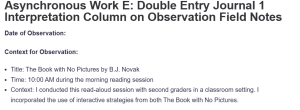Asynchronous Work E: Double Entry Journal 1 Interpretation Column on Observation Field Notes
Date of Observation:
Context for Observation:
- Title: The Book with No Pictures by B.J. Novak
- Time: 10:00 AM during the morning reading session
- Context: I conducted this read-aloud session with second graders in a classroom setting. I incorporated the use of interactive strategies from both The Book with No Pictures.
Inquiry Question: What happens when I structure my read-aloud sessions to include interactive elements from The Book with No Pictures?
Approach/Strategies:
- Interactive Participation: Mimic funny sounds and actions from The Book with No Pictures.
| INTERPRETATION OF DATA | DATA |
| Observation 1: When reading The Book with No Pictures, students laughed and shouted funny responses when I prompted them.
Observation 2: During the reading, when I reached a part where The Book with No Pictures suggested a funny action, a student exclaimed, “Let’s do it together!”
Observation 3: A few students hesitated to participate but gradually joined in when they saw their peers laughing.
Observation 4: At the end of the read-aloud of The Book with No Pictures, I asked, “What was your favorite sound we made?” Several students chimed in with their favorites, with one saying, “I liked the silly voice the best!” |
When I read the line instructing the students to make a funny sound, the least count I got was five students who laughed and imitated the sound. This made me believe that they were fully following the content that was read and found the jokes amusing. This mean that the interactive part was able to engage their attention as well as improve their understanding of the story.
The excitement on the students’ faces and their willingness to participate not only captured their interest but also encouraged them to actively engage with the story.
In the beginning, some students did not want to interact with the activity at all. However, the positive feedback from their peers motivated them to join in. This means that peer interaction can influence a child’s attitude toward learning, which is important in the group learning environment.
Students were able to immediately recall moments from the reading, and the discussion was quite spirited. The fact that they were able to discuss what they liked most shows that the interactive strategies not only made the session fun but also useful in improving their understanding of the content. |
ORDER A PLAGIARISM-FREE PAPER HERE
We’ll write everything from scratch
Question
Please Note: This document contains both self-observation instructions and Asynchronous Work E Instructions because students must carry out the self-observation before completing the Double Entry Journal. The self-observations are carried out as part of the fieldwork.
SELF-OBSERVATION INSTRUCTIONS:
Please wait to get feedback on the Inquiry Question & Rationale (Asynchronous Work C) before carrying out this observation.
Carry out your first self-observation by engaging the children in your class in a read aloud in which you use the approach/strategies that you identified in Asynchronous Work C (Inquiry Question & Rationale). During the observation or right after it, take field notes specifically focusing on the ways your children responded to the specific approach/strategies you used. In other words, your field notes should focus on information that pertains to your Inquiry Question. The field notes should include children’s verbal responses (what specific children said) and non-verbal responses (what specific children did, such as smiling, pointing, turning away, etc…). You will have multiple pages of field notes.
ASYNCHRONOUS WORK E INSTRUCTIONS:
For Asynchronous Work E, go through your fieldnotes of the self-observation and pick at least four instances that stood out for you because they pertain to the Inquiry Question. Include these in the “Data” column, making sure to provide appropriate contextual information (what part of the book were you reading at the time and what approach/strategy were you using) as well as pertinent information what you were saying/doing and and specific descriptions of how children were responding (both verbal and non-verbal responses). In the “Interpretation of Data” column, explain why you think students responded in this way to your approach/strategies and how their responses relate to literacy. Be as thoughtful as possible when interpreting the data.

Asynchronous Work E: Double Entry Journal 1 Interpretation Column on Observation Field Notes
Bring the double entry journal to class on 10/22/24 so that we can discuss it together in small groups.
———————————————————————————————————————————
DOUBLE ENTRY JOURNAL FORMAT
Date of Observation: (include the date in which you carried out the read aloud)
Context for Observation: (Include the following: the title and author of the read aloud book you used, when during the day the read aloud happened, and any other brief contextual information you feel is pertinent)
Inquiry Question: (Include your Inquiry Question here. If your professor gave you feedback on how to revise your Inquiry Question, include the revised Inquiry Question here.)
Approach/Strategies: (Identify the strategies that you will be using to explore your Inquiry Question here. Unless the professor has asked you to revise them, these should be the same as the ones identified in Asynchronous Work C.)
Please make sure to line up each segment of data with its interpretation.
| INTERPRETATION OF DATA | DATA |

